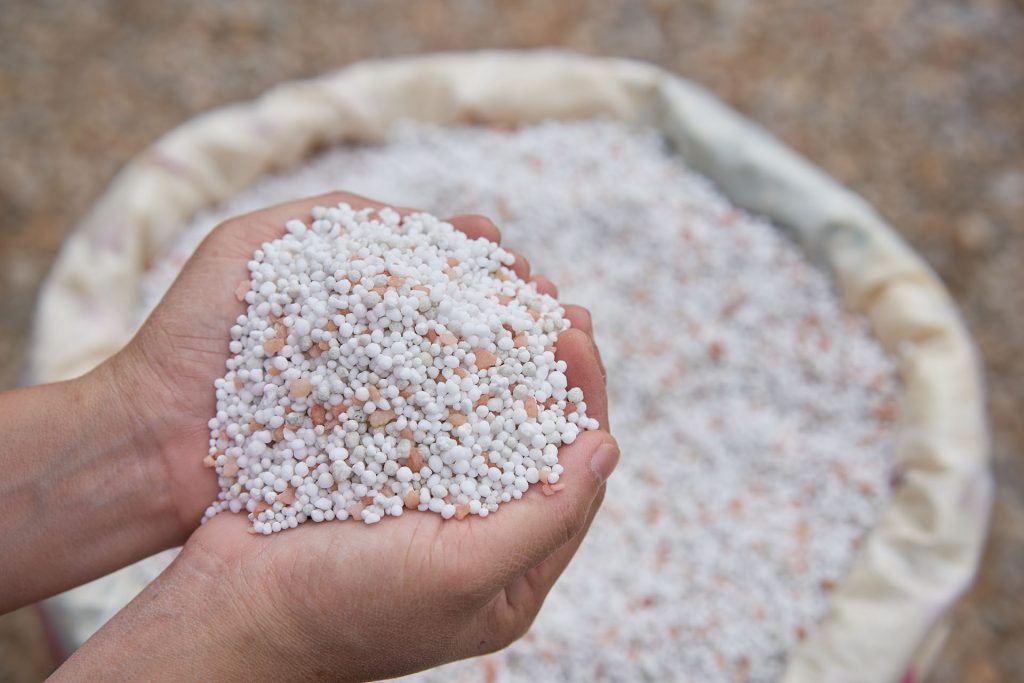
Everyone loves a bright green lawn, but sometimes the soil can get in the way of healthy grass. Adding lime to the soil of your grass is an effective way to boost soil pH while also encouraging proper growth. Lime used for grass comes from natural limestone. The rock is finely ground and then used to treat the soil in lawns, gardens and other parts of the landscape. Limestone has a high concentration of natural magnesium carbonate and calcium carbonate which is what is used to neutralize acidic soil. If you are curious about liming your lawn, our beginner’s guide is a quick way to learn the basics.
Why Should I Put Lime On My Lawn?
When it comes to proper lawn care, lime is critically important. Lime will ensure that your lawn has an adequate supply of calcium, and it will also ensure your soil has a balanced pH. If you have highly acidic soil, the best and also a cost-effective solution for neutralizing is liming. Lime will naturally break down in the soil over time. As this process progresses, it will trigger the rise of calcium in the soil particles. During the rise, the acidic components will be replaced. Your lawn contains hydrogen and potassium, which are both acidic, they react with the carbonates in the lime transforming them into neutral components. Once they have turned into water, carbon dioxide, and neutralized clay, they can better support the growth of healthy plants, in this instance, grass.
Can You Apply Lime And Fertilizer At The Same Time?
Although you can fertilize your lawn and apply lime to the soil at the same time, it is not recommended. Before liming your lawn, it is a good idea to test your soil to see which product is needed most. A professional lawn or gardening company can test the soil before treating your yard, or you can pick up a soil testing kit from the hardware store. Both lime and fertilizer are growth supplements, but they have very different jobs. Your fertilizer will help feed your plants and grass the nutrients they need to thrive. Lime, on the other hand, is used to reduce the level of acid in the soil which will make the nutrients easier to absorb. Knowing the pH of your soil will let you know which step should be taken first.
If you have your lawn tested and see that the soil acidity is too high, your lawn won’t get the maximum benefit of the fertilizer. In this case, it is important to lime your lawn first. This will prevent the buildup of unabsorbed nitrates which can further increase the acid levels in the soil. Once the lime has balanced the pH of the soil, you can then apply fertilizer to help boost the growth of your grass.
![A Beginners Guide to Liming Your Lawn [infographic]](https://theturfgrassgroup.com/wp-content/uploads/2021/03/A-Beginners-Guide-to-Liming-Your-Lawn-infographic.jpg)
When Is The Best Time To Put Down Lime?
Timing is very important when liming your lawn. It takes time for lime to break down in the soil and transform the pH. How long the deacidification process takes will depend on the condition of the soil, the type of lime you use, how it is applied, and how well it has been interred into the soil. Working with a professional lawn care company can make the process quicker since they will know the best type of lime and how to apply it according to your specific soil concerns.
In general, the best time to lime your lawn will be in the fall. This will give the lime plenty of time to transform your acidic soil before the next growing season. The chemical reaction of lime in the soil is pretty slow, so if you are looking for quick results for your lawn, you may need to consider soil replacement. The middle of summer is the worst time to lime your lawn. High heat can negatively affect the chemical process and cause the pH levels in your soil to become further imbalanced. You should also avoid liming your lawn when there is a danger of frost. Freezing pretty much brings the chemical process to a standstill, and the moisture may also dilute the lime and prevent proper pH neutralizing.
How To Apply Lime To Your Lawn & Soil
The most common form of lime used for grass is Dolomitic lime. You can contact a professional lawn care specialist to take care of liming your lawn or can do it on your own if you have experience. Lime for lawncare comes in both pellet and powder form. Both are equally effective in stabilizing the pH of the soil. Lime is applied to grass via a tiller or a drop spreader. This ensures that the application is even and that no one area gets too much lime. The more finely ground the lime, the quicker it will react in your soil.
We recommend hiring professionals to take care of liming your lawn. The process can be messy, and lime powder can be harmful if inhaled. Wearing a commercial-grade breathing mask will help limit exposure, but it is important to clean the surrounding surfaces once it has been applied to the lawn. Lime powder will often stick to paves surfaces and can erode plastics if not properly cleaned. Most lawn care companies will use lime pellets to help prevent many of the cleanup and breathing complications that come with the lime application. Another advantage of using lime pellets is that they are formulated for timed release. This will ensure proper coverage for your entire yard.
The Benefits Of Applying Lime To Your Lawn
The soil under your lawn is full of critical macronutrients that will help your lawn grow. Nutrients such as potassium, phosphorus, nitrogen, iron, boron, zinc, and many others. There has to be a perfect balance of these nutrients if you want to have a luscious green lawn. When the pH of the soil goes above 6.5, a breakdown of nutrients occurs that can cause a nutrient deficiency. When there is a deficiency, not only will your lawn fail to thrive, the soil can become toxic and actually cause it to die out completely.
One way to tell if your soil may be acidic is if you notice withering grass blades, yellow patches in the grass, sod that is slow-knitting, or a general reduction in the density of the turf. Acidity can be caused by any number of external factors. Too much rain can cause the alkaline to run off which will cause an increase of acidity, or it can even be caused by over-fertilization. Whatever the cause, your lawn will benefit from a lime application.
By neutralizing acidic soil with lime, your grass will be healthier, look more attractive, and grow much quicker. Lime also has a positive effect on the overall structure of the underlying soil. This will improve moisture retention and boost airflow. Not only is lime beneficial for your lawn, but it can also help improve the quality of your garden soil.
What Happens If I Use Too Much Lime?
Liming your lawn is an effective way to help the soil restore itself to a healthy pH, which in turn will give you healthier grass. Liming should always be left to the professionals, but if you did lime your lawn on your own and notice a problem, chances are you used too much. Using too much lime on your lawn will remove the acidity from the soil, but it will also make it too alkaline for your grass to thrive. This will cause yellowing grass that is also not able to absorb vital moisture and nutrients from the soil around it.
The best way to fix an over-liming is to have a professional lawn care company test the soil and administer a customized solution. You can also spend several weeks mulching in fresh organic materials to help dilute the lime. Or, as a last resort, you can apply horticultural sulfur to your lawn to try to counteract the lime and restore your soil to a healthy pH level.
Is Lime Harmful For Pets or People?
There are a couple of types of lime, in general, those used for lawn care are either in powder form or pellet form. Liquid lime for the lawn is also available, but generally not used outside of professional services. Lime is natural, however, it is not intended for consumption. For people, it is important to wear a heavy-duty mask when working with powder lime. For pellet lime, it is important not to allow pets or small children to consume the pellets. They have the potential to cause irritation of the skin, eyes, and stomach, but other than intentional ingestion, lime is not harmful. Always ensure that the lime has been properly incorporated into the soil before allowing pets to roam freely. It is also a good idea for humans to avoid the soil until the lime has had a chance to properly soak in.
Of course, the most important thing you can do is start with high-quality sod, like TifTuf Bermuda or Zeon Zoysia. You can find a grower near you here.
